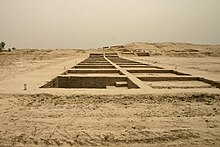 Archaeological site at Baror Archaeological site at Baror | |
  | |
| Location | Sri Ganganagar district, Rajasthan, India |
|---|---|
| Type | Archaeological site |
| Part of | Indus Valley civilization |
| Area | 200 × 150 m |
| Height | 11 m |
| Site notes | |
| Excavation dates | 2003–2004, 2006–2007 |
| Archaeologists | Luigi Pio Tessitori, Amlanand Ghosh |
Baror is an archeological site in Sri Ganganagar district of Rajasthan, India. It belongs with ancient Indus Valley civilization. Pre Harappan and Harappan pottery has been found after excavation.
Location
Show zoomed outShow zoomed midShow zoomed inIt is located in the south part of Sri Ganganagar district of Rajasthan, about 13 km northeast of Anupgarh, near the Pakistan border. It is situated about 100 km southwest of Kalibangan, in the dry bed of Ghaggar river.
The mound of Baror measures about 200 × 150 m and rises to a height of 11 m from its surrounding plain.
Discovery
| Discovered by | Luigi Pio Tessitori, Italian Indologist in 1916–17 |
| Post-Independence Survey | Amlānand Ghosh, Ex. Director General, Archaeological Survey of India |
The identity of Baror a pre-historic site was discovered by Luigi Pio Tessitori, an Italian Indologist (1887–1919) in 1916–17. After independence of India, Amlānand Ghosh (Ex. Director General, Archaeological Survey of India) did a detailed survey of this site.
In 2003–04, the Indian archaeological survey started excavation under Sarasvati Heritage Project. A 400×300 square area was selected for excavation.
In 2006–07, houses constructed with tiles, as well roads were discovered.
Excavation
- Archeological Findings
- Period I – Pre-Harappan
- Characteristics:
- Ceramics made on wheel
- Red-colored without painting
- Coarse to medium fabric
- Well-levigated clay
- Discoveries:
- Storage jars and miniature pots
- Few sherds of grey color
- Remains of Hakra period ware
- Characteristics:
- Period II – Harappan
- Discoveries:
- Mud brick houses (oriented north-south)
- Discoveries:
- Period III – Mature Harappan
- Discoveries:
- Remains of mud brick houses (oriented north-south along roads)
- Discoveries:
- Other Discoveries
- Terracotta Items:
- Circular and triangular cakes
- Sling balls with pinched decoration
- Circular beads and spacer
- Jewelry and Ornaments:
- Skeleton with ornaments
- Pitcher with 8000 pearls
- Miscellaneous Finds:
- Stones producing red-colored dust
- 5-meter long, 3-meter clay oven
- Period I – Pre-Harappan
The archeologists have found pottery of Pre Harappan and Harappan period.
A three-fold cultural sequence was established,
- Period I – Pre-Harappan
Ceramics were made on wheel; they were red coloured and devoid of any painting. The fabric is coarse to medium, and made out of well-levigated clay. Storage jars, and miniature pots were found, as well as a few sherds of grey colour.
The remains of the Hakra period ware were found here at the lowest levels.
- Period II – Harappan
- Period III – Mature Harappan
The remains of mud brick houses were exposed. They were oriented north south along roads
Other discoveries
The circular and triangular terracotta cakes, sling balls with pinched decoration, circular beads and spacer, terracotta, faience and shell bangles, were also found.
Other discoveries include,
- 1. A skeleton of a human with ornaments has been found.
- 2. Two stones have been found which produce red-coloured dust after rubbing with each other.
- 3. A 5-meter long and 3-meter clay oven also has been discovered.
- 4. A pitcher filled with 8000 pearls has been found here.
See also
References
- Baror – Archaeological Survey of India
- Baror – Archaeological Survey of India
- Baror – Archaeological Survey of India
- Samunder and Vivek Dangi (2014), Explorations along "Lost" River Sarasvati (SuratgarhTehsil, Sri Ganganagar District, Rajasthan)
- "Baror near Ramsinghpur". Rajasthan Patrika newspaper. 19 June 2006.
Bibliography
- A. Ghosh (ed.), An Encyclopaedia of Indian Archaeology in 2 Volumes, II (New Delhi 1989)
- S.P. Gupta (ed.), An Archaeological Tour Along the Ghaggar-Hakra River by Sir Aurel Stein (Meerut 1989)
- Urmila Sant, Terracotta Art of Rajasthan (New Delhi 1997)
29°10′08″N 73°18′49″E / 29.169°N 73.3136°E / 29.169; 73.3136
Categories: